Blu-Ray theme by Evlyti
Download: Blu-Ray_2.p3t

(1 background)
Redirect to:
This page is a redirect. The following categories are used to track and monitor this redirect:
|

The #1 spot for Playstation themes!
Blu-Ray theme by Evlyti
Download: Blu-Ray_2.p3t

(1 background)
Redirect to:
This page is a redirect. The following categories are used to track and monitor this redirect:
|
Phishy theme by Fully Rendered
Download: Phishy.p3t
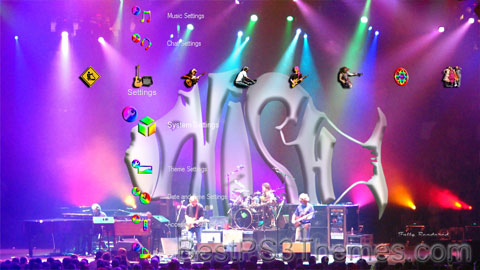
(3 backgrounds, HD only)
P3T Unpacker v0.12
Copyright (c) 2007. Anoop Menon
This program unpacks Playstation 3 Theme files (.p3t) so that you can touch-up an existing theme to your likings or use a certain wallpaper from it (as many themes have multiple). But remember, if you use content from another theme and release it, be sure to give credit!
Download for Windows: p3textractor.zip
Instructions:
Download p3textractor.zip from above. Extract the files to a folder with a program such as WinZip or WinRAR. Now there are multiple ways to extract the theme.
The first way is to simply open the p3t file with p3textractor.exe. If you don’t know how to do this, right click the p3t file and select Open With. Alternatively, open the p3t file and it will ask you to select a program to open with. Click Browse and find p3textractor.exe from where you previously extracted it to. It will open CMD and extract the theme to extracted.[filename]. After that, all you need to do for any future p3t files is open them and it will extract.
The second way is very simple. Just drag the p3t file to p3textractor.exe. It will open CMD and extract the theme to extracted.[filename].
For the third way, first put the p3t file you want to extract into the same folder as p3textractor.exe. Open CMD and browse to the folder with p3extractor.exe. Enter the following:
p3textractor filename.p3t [destination path]Replace filename with the name of the p3t file, and replace [destination path] with the name of the folder you want the files to be extracted to. A destination path is not required. By default it will extract to extracted.filename.
Rainbow Six Vegas 2 version 2 theme by SeoulSpirit
Download: RainbowSixVegas2V2.p3t
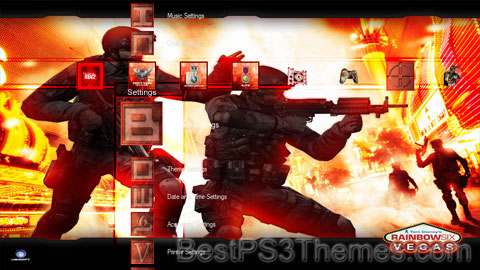
(1 backgrounds)
P3T Unpacker v0.12
Copyright (c) 2007. Anoop Menon
This program unpacks Playstation 3 Theme files (.p3t) so that you can touch-up an existing theme to your likings or use a certain wallpaper from it (as many themes have multiple). But remember, if you use content from another theme and release it, be sure to give credit!
Download for Windows: p3textractor.zip
Instructions:
Download p3textractor.zip from above. Extract the files to a folder with a program such as WinZip or WinRAR. Now there are multiple ways to extract the theme.
The first way is to simply open the p3t file with p3textractor.exe. If you don’t know how to do this, right click the p3t file and select Open With. Alternatively, open the p3t file and it will ask you to select a program to open with. Click Browse and find p3textractor.exe from where you previously extracted it to. It will open CMD and extract the theme to extracted.[filename]. After that, all you need to do for any future p3t files is open them and it will extract.
The second way is very simple. Just drag the p3t file to p3textractor.exe. It will open CMD and extract the theme to extracted.[filename].
For the third way, first put the p3t file you want to extract into the same folder as p3textractor.exe. Open CMD and browse to the folder with p3extractor.exe. Enter the following:
p3textractor filename.p3t [destination path]Replace filename with the name of the p3t file, and replace [destination path] with the name of the folder you want the files to be extracted to. A destination path is not required. By default it will extract to extracted.filename.
Sakuretsu theme by hikaru
Download: Sakuretsu.p3t

(2 backgrounds)
P3T Unpacker v0.12
Copyright (c) 2007. Anoop Menon
This program unpacks Playstation 3 Theme files (.p3t) so that you can touch-up an existing theme to your likings or use a certain wallpaper from it (as many themes have multiple). But remember, if you use content from another theme and release it, be sure to give credit!
Download for Windows: p3textractor.zip
Instructions:
Download p3textractor.zip from above. Extract the files to a folder with a program such as WinZip or WinRAR. Now there are multiple ways to extract the theme.
The first way is to simply open the p3t file with p3textractor.exe. If you don’t know how to do this, right click the p3t file and select Open With. Alternatively, open the p3t file and it will ask you to select a program to open with. Click Browse and find p3textractor.exe from where you previously extracted it to. It will open CMD and extract the theme to extracted.[filename]. After that, all you need to do for any future p3t files is open them and it will extract.
The second way is very simple. Just drag the p3t file to p3textractor.exe. It will open CMD and extract the theme to extracted.[filename].
For the third way, first put the p3t file you want to extract into the same folder as p3textractor.exe. Open CMD and browse to the folder with p3extractor.exe. Enter the following:
p3textractor filename.p3t [destination path]Replace filename with the name of the p3t file, and replace [destination path] with the name of the folder you want the files to be extracted to. A destination path is not required. By default it will extract to extracted.filename.
Premium theme by Sundersnake
Download: Premium.p3t
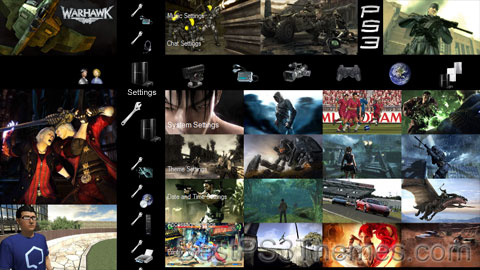
(2 backgrounds)
Premium may refer to:
Pacman theme by David619
Download: Pacman.p3t
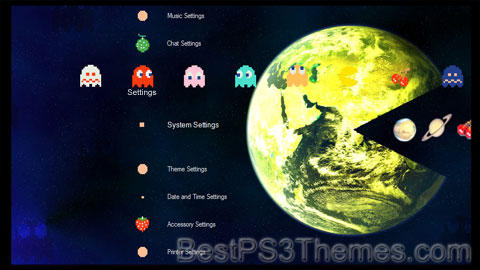
(1 background)
Redirect to:
This page is a redirect. The following categories are used to track and monitor this redirect:
|
New York Mets theme by Rickey
Download: NewYorkMets.p3t
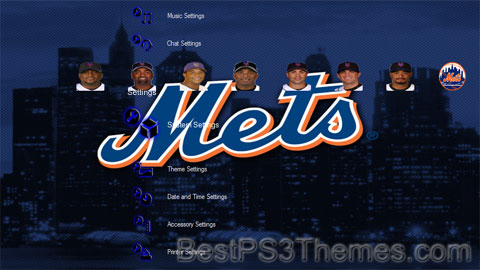
(3 backgrounds)
| New York Mets | |||||
|---|---|---|---|---|---|
| |||||
| |||||
| Major league affiliations | |||||
| |||||
| Current uniform | |||||
 | |||||
| Retired numbers | |||||
| Colors | |||||
| Name | |||||
| |||||
| Other nicknames | |||||
| Ballpark | |||||
| |||||
| Major league titles | |||||
| World Series titles (2) | |||||
| NL Pennants (5) | |||||
| NL East Division titles (6) | |||||
| Wild card berths (4) | |||||
| Front office | |||||
| Principal owner(s) | Steve Cohen Alexandra M. Cohen | ||||
| President | Steve Cohen (CEO) | ||||
| President of baseball operations | David Stearns | ||||
| General manager | Vacant | ||||
| Manager | Carlos Mendoza | ||||
| Website | mlb.com/mets | ||||
The New York Mets are an American professional baseball team based in the New York City borough of Queens. The Mets compete in Major League Baseball (MLB) as a member of the National League (NL) East Division. They are one of two major league clubs based in New York City, the other being the New York Yankees of the American League (AL). One of baseball's first expansion teams, the Mets were founded in 1962 to replace New York's departed NL teams, the Brooklyn Dodgers and the New York Giants.[7] The team's colors evoke the blue of the Dodgers and the orange of the Giants.[1]
For the 1962 and 1963 seasons, the Mets played home games at the Polo Grounds in Manhattan before moving to Queens. From 1964 to 2008, the Mets played their home games at Shea Stadium, named after William Shea, the founder of the Continental League, a proposed third major league, the announcement of which prompted their admission as an NL expansion team.[8] Since 2009, the Mets have played their home games at Citi Field next to the site where Shea Stadium once stood.
In their inaugural season, the Mets posted a record of 40–120, the worst regular-season record since MLB went to a 162-game schedule. The team never finished better than second-to-last in the 1960s until the "Miracle Mets" beat the Baltimore Orioles in the 1969 World Series, considered one of the biggest upsets in World Series history despite the Mets having won 100 games that season.[9] The Mets have qualified for the postseason ten times, winning the World Series twice (1969 and 1986) and winning five National League pennants (most recently in 2000 and 2015), and six National League East division titles.
Since 2020, the Mets have been owned by billionaire hedge fund manager Steve Cohen, who purchased the team for $2.4 billion.[10] As of 2023, Forbes ranked the Mets as the sixth most valuable MLB team, valued at $2.9 billion.[11]
As of the end of the 2023 regular season, the team's overall win–loss record is 4,727–5,075–8 (.482).[12]

After the 1957 season, the Brooklyn Dodgers and New York Giants relocated from New York to California to become the Los Angeles Dodgers and San Francisco Giants, leaving the largest city in the United States with no National League franchise and only one major league team, the New York Yankees of the American League (AL). With the threat of a New York team joining the new Continental League, the National League expanded by adding the New York Mets following a proposal from William Shea. In a symbolic reference to New York's earlier National League teams, the new team took as its primary colors the blue of the Dodgers and the orange of the Giants, both of which are colors also featured on the Flag of New York City. The nickname "Mets" was adopted: being a natural shorthand to the club's corporate name, the "New York Metropolitan Baseball Club, Inc.",[13][14][15] which hearkened back to the "Metropolitans" (a New York team in the American Association from 1880 to 1887),[1] and its brevity was advantageous for newspaper headlines.[16]

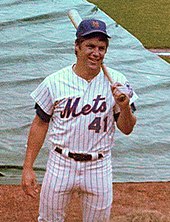
The 1962 Mets posted a 40–120 record, a major league record for the most losses in a season since 1899.[17] During the 1963 season the team featured a pitcher, Carlton Willey, who was having a great year, pitching four shut-outs, when he incurred an injury and finished with a 9–14 win–loss record. The '63 squad also had Duke Snider, who hit his 2,000th hit and later his 400th home run and earned a berth to the 1963 All-Star Game. In 1964, the Mets hired Yogi Berra as a coach under Casey Stengel's coaching staff.[18]
In 1966, the Mets famously bypassed future Hall of Famer Reggie Jackson in the amateur draft, instead selecting Steve Chilcott, who never played in the majors. But the following year, they acquired future Hall of Famer Tom Seaver in a lottery.[19] Seaver helped the 1969 "Miracle Mets" win the new National League East division title, then defeat the Atlanta Braves to win the National League pennant and the heavily favored Baltimore Orioles to win the 1969 World Series.[20]
In 1973, the Mets rallied from 5th place to win the division, despite a record of only 82–79.[21] They shocked the heavily favored Cincinnati Reds' "Big Red Machine" in the NLCS and pushed the defending World Series champion Oakland Athletics to a seventh game, but lost the series. Notably, 1973 was the only NL East title between 1970 and 1980 that was not won by either the Philadelphia Phillies or the Pittsburgh Pirates.[22][23] Star pitcher Tom Seaver was traded in 1977, on a day remembered as "the Midnight Massacre",[24] and the Mets fell into last place for several years.
In January 1980, the Payson heirs sold the Mets franchise to the Doubleday publishing company for $21.1 million, a record amount at that time. Nelson Doubleday, Jr. was named chairman of the board while minority shareholder Fred Wilpon took the role of club president. In February, Wilpon hired longtime Baltimore Orioles executive Frank Cashen as general manager who began the process of rebuilding the Mets much in the same way he developed the Orioles in the late 1960s and early 1970s.[25]
The franchise turned around in the mid-1980s. During this time the Mets drafted slugger Darryl Strawberry (#1 in 1980)[26] and 1985 Cy Young Award winner Dwight Gooden (#5 in 1982).[27] Former National League MVP and perennial Gold Glove winner Keith Hernandez was obtained by the Mets in 1983 from the St. Louis Cardinals.[28][29] This began a rivalry between the two teams that lasted throughout the rest of the 1980s, during which the teams would swap NL East titles between 1985 and 1988, Mets players openly trolled the Cardinals, and Cardinals fans nicknamed the Mets "pond scum."[30][31]
After finishing their first three campaigns of the 1980s decade in either 5th or 6th (last) place, in 1984, new manager Davey Johnson was promoted from the helm of the AAA Tidewater Tides.[32] He led the Mets to a second-place, 90–72 record, their first winning season since 1976.[33]
In 1985, they acquired Hall of Fame catcher Gary Carter from the Montreal Expos and won 98 games, but narrowly missed the playoffs.[34][35] In 1986, they won the division with a record of 108–54, one of the best in National League history.[36] They then won a dramatic NLCS in six games over the Houston Astros.[37] The sixth game of the series lasted sixteen innings, the longest playoff game in history until 2005. The Mets came within one strike of losing the World Series against the Boston Red Sox before a series of hits and defensive miscues ultimately led to an error by Boston's Bill Buckner which gave the Mets a Game 6 victory. The Mets won their second World Series title in seven games.[38][39]
In 1987 the Mets declined to re-sign World Series MVP Ray Knight, who then signed with the Baltimore Orioles and also traded away the flexible Kevin Mitchell to the Padres for long-ball threat Kevin McReynolds.[40] Weeks later Mets' ace Dwight Gooden was admitted to a drug clinic after testing positive for cocaine.[41] Despite Gooden struggling in the first few months of the 1987 season, "Dr. K" rebounded, as did the team. It was during the tough times that the Mets made a great long-term deal, trading Ed Hearn to the Kansas City Royals for pitcher David Cone.[42]
The rivalry with the Cardinals culminated in the 1987 season, when the Mets surged to challenge them for the NL East title but suffered two painful losses. The first came on Seat Cushion Night where Tom Herr hit a walk-off grand slam. A greater loss came on September 11 in a game against St. Louis, 3rd baseman Terry Pendleton hit a homer to give the Cardinals a lead, and eventually the NL East title.[43] One highlight of the year was Darryl Strawberry and Howard Johnson becoming the first teammates' ever to hit 30 homers and steal 30 bases in the same season.
The Mets rebounded the following year to post a 100–60 overall record and win their division in 1988, but lost in the NLCS that year to the Los Angeles Dodgers and declined into the 1990s.
During the 1991 season, the Mets were actually in contention for much of the season, closing to within 2.5 games of the front-running Pirates at one point. In the latter half, however, the bottom completely fell out and Harrelson was fired with a week left to go in the season, replaced by third base coach Mike Cubbage for the final games. Jefferies was once again a distraction as he released a controversial statement to be read on WFAN radio:[44]
When a pitcher is having trouble getting players out, when a hitter is having trouble hitting, or when a player makes an error, I try to support them in whatever way I can. I don't run to the media to belittle them or to draw more attention to their difficult times. I can only hope that one day those teammates who have found it convenient to criticize me will realize that we are all in this together. If only we can concentrate more on the games, rather than complaining and bickering and pointing fingers, we would all be better off.
This was seen as the end for Jefferies in New York as he would be traded to the Kansas City Royals in the offseason. The season ended on a high note, however, as David Cone pitched a one-hit shutout against the Phillies at Veterans Stadium, in which he struck out 19 batters, tying the National League regulation game record (first set by former Met Tom Seaver).[45] With all of the personal problems swirling around the Mets after the 1986 championship, the Mets tried to rebuild using experienced superstars. They picked up Eddie Murray for over $3 million, Bobby Bonilla for over $6 million.[46][47] They also traded McReynolds and Jefferies for one-time World Series hero Bret Saberhagen and his $3 million contract, along with signing veteran free agent pitcher Frank Tanana for $1.5 million. The rebuilding was supported by the slogan, "Hardball Is Back".[48]
The experiment of building a team via free agency quickly flopped as Saberhagen and Vince Coleman were soon injured and spent more time on the disabled list than on the field, and Bonilla exhibited unprofessional behavior towards members of the press, once threatening a reporter by saying, "I'll show you The Bronx" [1]. At the beginning of the 1991 season, Coleman, Gooden and outfielder Daryl Boston were named in an alleged sexual abuse incident against a woman near the Mets' spring training facility; the charges were later dropped. Meanwhile, popular pitcher David Cone was dealt to the Toronto Blue Jays during the 1992 season for Ryan Thompson and Jeff Kent. While the move was widely criticized by fans of both teams, the Jays went on to win the 1992 World Series. Their descent was chronicled by the book The Worst Team Money Could Buy: The Collapse Of The New York Mets (ISBN 0-8032-7822-5) by Mets beat writers Bob Klapisch and John Harper.
The lowest point of the experiment was the 1993 season when the Mets lost 103 games. In April of that year, Coleman accidentally hit Gooden's shoulder with a golf club while practicing his swing.[49] In July, Saberhagen threw a firecracker under a table near reporters.[50] Their young pitching prospect Anthony Young started the 1993 season at 0–13 and his overall streak of 27 straight losses over two years set a new record. After Young's record-setting loss, Coleman threw a firecracker out of the team bus window and injured three people resulting in felony charges that effectively ended his Mets career; the Mets placed him on paid administrative leave for the remainder of the season, and announced less than a month before the end of the season that he would never play for them again. Only a few days later, Saberhagen was in trouble again, this time for spraying bleach at three reporters.[51] The meltdown season resulted in the worst record for a Mets team since 1965. In addition, two of the three remaining links to the 1986 team, Howard Johnson and Sid Fernandez, departed after the season via free agency.
The following season saw some promise for the troubled Mets, as first baseman Rico Brogna and second baseman Jeff Kent became fan favorites with their solid glove work and potential 20–25 home run power, Bonilla started to become the player the Mets expected, and a healthy Saberhagen, along with promising young starter Bobby Jones and John Franco, helped the Mets pitching staff along. In the strike-shortened 1994 season the Mets were in 3rd place behind first-place Montreal and